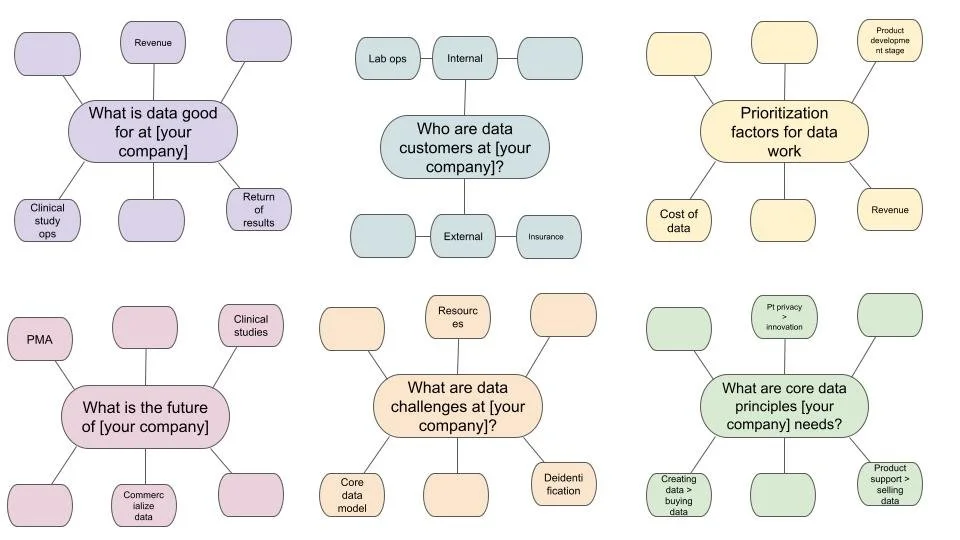Writing roadmaps for data platforms
Data teams in biotech often feel like secondary citizens, particularly when data strategy doesn't directly link to immediate company revenue. However, data teams can demonstrate value by crafting roadmaps that clearly and directly link to the bottom line. Here’s how I think about building an effective data vision.
Identify Your Company's Bottom Line
Understand your company's mandate and the obstacles to achieving it. Take a two fold approach:
Map current and future revenue sources. I recommend creating a spider map to identify key themes. Here’s an example of some questions and options to map out. These will help start to make associations between data strategy and business needs. This is especially helpful for startups where the business roadmap is still nascent and may not be obvious to teams on the ground.
An example spider map with questions I’d have on the top of my mind
2. Conduct interviews with key stakeholders across different departments to understand their challenges, needs, and how they perceive data's role. This will hopefully ensure your understanding of the business mandate isn't just top-down but informed by the actual realities of your company’s operations today.
Write a one pager
Develop a concise document (ideally a one pager) outlining your company's mandate, bottlenecks, and how a data team/platform will directly address them. When reading your doc, your CEO should immediately grasp why data platforms are a mission-critical investment and what the ROI is. Keep it jargon-free and straightforward—similar to Amazon's approach of writing press releases for unreleased features.
Key questions to address:
How does the data platform value prop align with business goals?
What unique value will your data platform provide in five years?
How can your data platform directly address bottlenecks to the company's mandate?
A stakeholder should walk away from your one pager with no doubt in their mind that investing in data is critical for the company’s bottom line.
Identify short term users
Map company teams to find potential data champions where quick wins are possible. This is especially helpful for data teams that are just being formed. Prioritize data resources towards initiatives that directly impact revenue or operational efficiency for critical programs, making sure to consider technical difficulty with potential impact. Don’t take 3 months to build the perfect technical solution for a problem that needed to be solved last week.
Priority examples:
P0 - Manufacturing or lab ops team need to triage system failures before a patient sample is destroyed.
P1 - Data science team wants to transition subsets of data to cold storage because storage costs are very high
P2 - Publication team needs data to submit an abstract to ASCO
P3 - R&D scientist needs data for a purely exploratory project
Identify metrics
After identifying short-term users, define clear success metrics for the platform. This helps make the value prop more concrete to stakeholders and leadership and creates a framework for demonstrating ROI for the platform.
Create 1-2 year roadmap
Convert priorities into 3-5 themed initiatives with effort estimates. Ask your team what they would build to drive company growth if unencumbered by other requests. Include technical specifics like platform choices and ingestion processes.
Resource planning
Outline the resources (people, tools, $$) needed to implement the 1-2 year strategy. This will get ahead of the common question from leadership: "This sounds great, but what will it cost?". This doesn’t have to be super fancy but should show that you know everything costs money.
Shop around
Develop a communication strategy for different audiences before starting to shop around. How you present the data vision to the C-suite has to differ from how you’d engage with potential user departments. Share your roadmap with internal and external stakeholders. Build consensus to establish the roadmap as a reference for prioritization decisions.
Iterate
Especially at startups, the data vision and strategy will have to be flexible to the company’s changing business model and customer needs. Revisit this vision and roadmap every 4-6 months with the team and assess if anything needs to change. Implement a lightweight process for continuous feedback from your stakeholder groups. Hopefully this will proactively catch shifting priorities before they become urgent redirections.
